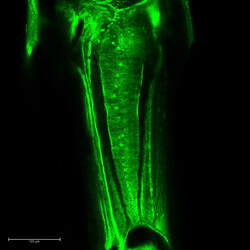ERC: The insect cochlea
 The Crista acustica of a crystal katydid Phlugis poecila.
The Crista acustica of a crystal katydid Phlugis poecila.
Advances in acoustic engineering are related to the fundamental understanding of the transmission of sound waves through structures with complex mechanical properties and processing via organs with advanced mechanochemical functions. The human cochlea has been a source of inspiration for acoustic sensors due its improved sensitivity, higher frequency range, and sharp frequency discrimination. However, despite the critical need for high-resolution acoustic sensors for numerous applications in engineering/medicine, current methods for elucidating cochlear function are inherently invasive, and deep understanding of its processes remains elusive, proving challenging its simulation in electromechanical devices. Yet, cochlear organ for frequency selectivity is not unique to mammalian audition. A simpler analogous mechanism for frequency analysis was recently found in the ears of bush-crickets or katydids (insects). These insects are endowed with outer middle and inner ear, but unlike mammals their "cochlea" is small (~0.6 mm), uncoiled, and exceptionally accessible through transparent cuticle. The katydid "cochlea" is known as the Crista Acustica and performs frequency analysis. These attributes facilitate the clean measurements of complex auditory processes impossible to attain in the mammalian cochlea, and open an exceptional opportunity for miniaturization and simplification of artificial acoustic sensors.
Using bush-crickets and relatives as model systems this project is designed to fulfil the following two main objectives: (1) to dissect the three ear components to i) identify the elements involved in acute hearing sensitivity, ii) characterise the role of multiple sound inputs in directional hearing, iii) associate the activation patterns of auditory afferents with mechanical waves in the insect cochlea. (2) Generate experimental data using state-of-art imaging and mechanical methods to produce computer models and theoretical analogues of the insect cochlea to propose innovative alternatives in the design of acoustic sensors. By using a multi-disciplinary approach between biology, engineering, physics and mathematics, this project is designed to develop new technological improvements that constitute the grounds of the next-generation of miniature, super-sensitive acoustic sensors. To attain these goals, the project is divided in various sub-projects and tasks which are being developed by a group of three Postdoctoral researchers and two PhD students. We are actively focusing and pursuing cutting-end research in the following categories:
Inner Ear Imaging & Mechanics
Structural and Chemical Composition of the Insect Ear
Evolution of Bush-cricket Hearing
Directional Hearing & Outer Ear Dynamics
Mathematical Modelling
Dissemination activities
Using bush-crickets and relatives as model systems this project is designed to fulfil the following two main objectives: (1) to dissect the three ear components to i) identify the elements involved in acute hearing sensitivity, ii) characterise the role of multiple sound inputs in directional hearing, iii) associate the activation patterns of auditory afferents with mechanical waves in the insect cochlea. (2) Generate experimental data using state-of-art imaging and mechanical methods to produce computer models and theoretical analogues of the insect cochlea to propose innovative alternatives in the design of acoustic sensors. By using a multi-disciplinary approach between biology, engineering, physics and mathematics, this project is designed to develop new technological improvements that constitute the grounds of the next-generation of miniature, super-sensitive acoustic sensors. To attain these goals, the project is divided in various sub-projects and tasks which are being developed by a group of three Postdoctoral researchers and two PhD students. We are actively focusing and pursuing cutting-end research in the following categories:
Inner Ear Imaging & Mechanics
Structural and Chemical Composition of the Insect Ear
Evolution of Bush-cricket Hearing
Directional Hearing & Outer Ear Dynamics
Mathematical Modelling
Dissemination activities

